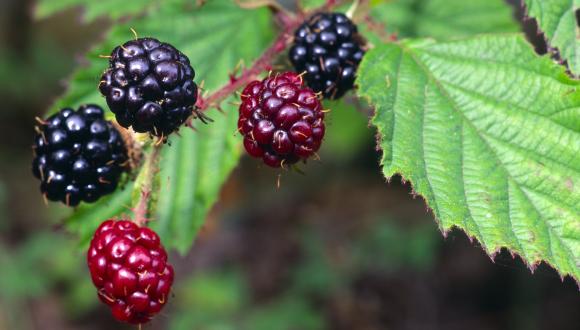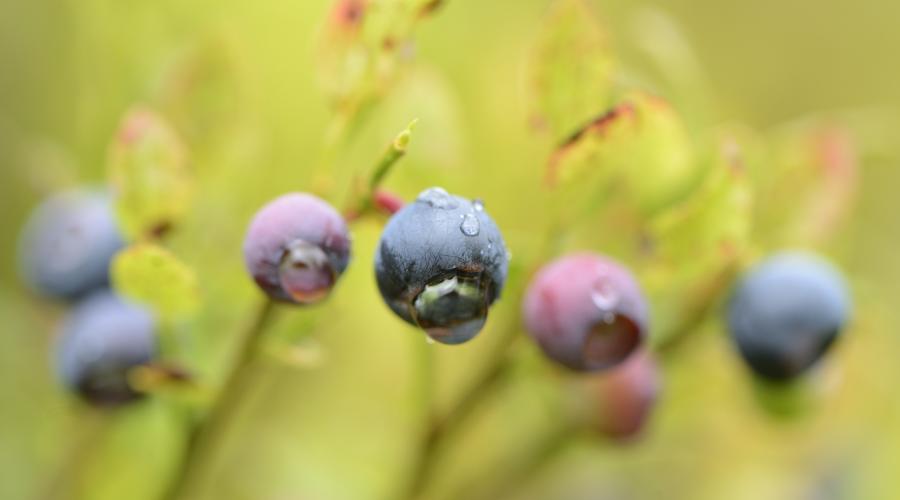
Foraging for Wild Plants
Here are some of the plants and seaweeds that can be gathered and eaten in Scotland. You must be 100% certain of your plant identification in order to avoid any poisonous plants which look similar. Make sure that you gather plants in a way that is mindful, responsible and completely sustainable. There is guidance for responsible foraging at the end.
This publication was originally written in Gaelic and developed in partnership with Bòrd na Gàidhlig as part of the Gaelic Foraging Project in which the rich language and culture of the Gaels and close links with nature are explored.
Responsible foraging – basic principles
Foraging is a good and healthy way to connect with nature. The number of people who enjoy foraging has increased greatly, and they are adding to their diet with food that is natural, tasty and nutritious.
We want you to take great pleasure in your foraging but also want you to do it in a way that is sympathetic to both the environment and to other people who use the same place. You will want to avoid places where lots of people exercise their dogs. If you follow the principles below, your foraging will be both mindful and inconspicuous.
You can be sympathetic to nature by:
- gathering carefully, avoiding damage to the plant roots or fungus mycelium
- selecting plants which are abundant, without gathering anything that is rare or unusual
- not taking too much from any one plant or tree and by gathering in different areas
- cutting, rather than tearing seaweed, to leave the ‘holdfast’ its ‘root’, attached to the rocks
- walking only where you need to, without trampling plants.
- taking away only what you will use, without removing too much and leaving enough for mammals, birds and insects. Sometimes this will be difficult as others may follow you, reducing what is left still further.
Stay safe:
- Make sure you are certain of the identity of the plants or fungus you are foraging. These skills require to be learned, but it becomes easy with experience
- Some plants and fungi are deadly poisonous; make sure you can recognise these. If you are in any doubt, do not pick.
- Be aware of changes in the weather and state of the tides if you are foraging at the shore.
- If you are gathering in wet places close to animal pasture, boil the plant, eg watercress, due to the danger of liver fluke.
Glossary
- anti-oxidant . . . . . . . . ana-ogsadant
- beech mast . . . . . . . . bàchar
- vitamin . . . . . . . . . . . beothaman
- spinach . . . . . . . . . . . bloinigean-gàrraidh
- fermenting . . . . . . . brachadh
- steaming (cooking) . ceò-theasachadh
- cloves . . . . . . . . . . . . . clomhais
- veins . . . . . . . . . . . . . . . cuislean
- parsnip . . . . . . . . . . . curran-geal
- wild (not cultivated) fiadhain
- fibre . . . . . . . . . . . . . . freumhag
- liver fluke . . . . . . . . . glup
- hemlock . . . . . . . . . . . . iteodha
- deadly poisonous ................. marbhtach puinnseanta
- radish . . . . . . . . . . . . . meacan-ruadh
- mineral . . . . . . . . . . . mèinnear
- potherb . . . . . . . . . . . praiseach
- horseradish . . . . . . . ràcadal
- foraging........... rùrachd
- (oxalic) acid . . . . . . . searbhag (ogsàlach)
- mustard . . . . . . . . . . . sgeallan
- sap . . . . . . . . . . . . . . . snodhach
- sustainable . . . . . . . . so-sheasmhach
- scurvy............. tachas tioram (an)
Photographs by Lorne Gill/NatureScot and Mark Williams.

Find out more
Listen to our latest Podcast 'Getting started with foraging' - September 2022
Forest and Field

Dandelion
Beàrnan Brìde
Use Tea or beer can be made from the leaves or roots. The roots (sliced) are good boiled and then fried for use in salads or stir fries (or raw in salads). The roasted roots can be mashed and made into a drink similar to coffee (which is caffeine free).
Health and other uses
Dandelion is a good source of iron, calcium and vitamin A.
Birch
Beith
Use Birch sap is a natural spring tonic and syrup can be made from it. The leaves can be used to give a wintergreen taste to vegetables.
Health and other uses
The sap is only available for a few weeks of the year and is collected by drilling into the trunk.
English Stonecrop
Biadh an t-Sionnaidh
Use The leaves can be eaten raw or boiled. They have a slightly peppery taste.
Health and other uses
Don’t eat too much of it raw as it contains alkaloids that can cause drowsiness or stomach pain.
Watercress
Biolair Uisge
Use Use older leaves which have a slightly ‘hot’ taste. Boil and use as a vegetable.
Health and other uses
Contains high levels of vitamin C. Avoid picking watercress near livestock and standing water due to the danger of fluke.
Hazel
Calltainn
Use The nuts are delicious roasted and can be used for desserts, cakes and sweets.
Health and other uses
Hazel nuts are a good source of vitamins B & E, K, Calcium, Magnesium. Hazel nuts are known as ‘Cnò an Eòlais’ or the ‘Nut of Knowledge’ in Gaelic folklore.
Rowan
Caorann
Use Rowan jelly is made from the berries in autumn – which adds a great taste to meat.
Health and other uses
High in vitamin C and fibre, and also an anti-oxidant. Do not eat the berries raw.
Coltsfoot
Cluas Liath
Use Some people eat the leaves and flowers - but avoid eating too many – and a tea can also be made from the flowers. The leaves appear after the flowers have gone.
Health and other uses
Coltsfoot is a plant that has long been cultivated for its medicinal properties and it’s often found in herbal preparations aimed at treating respiratory infections and sore throats. However, it’s also controversial, as research has linked some of its key components to liver damage, blood clots, and even cancer.
Pignut
Cnò-thalmhainn
Use The tubers, found by carefully following the thin underground stalk, are very tasty. They can be eaten raw and have a ‘nutty’ taste.
Health and other uses
Pignut can be abundant in old grassland, but don’t harvest too many.
Cow Parsley
Costag Fhiadhain
Use The leaves may be used as an alternative to parsley – they are good with fish. But note - cow parsley sometimes grows beside hemlock which looks very similar and is deadly poisonous. Familiarity with the carrot family in general (umbellifers) is essential.
Health and other uses
Cow parsley is common except in the northern Highlands, Lewis and Harris. The Gaelic name ‘costag fhiadhain’ means ‘wild chervil’.
Wild Garlic, Ramsons
Creamh
Use The leaves of wild garlic appear in spring and may be used as an alternative to spring onions or garlic and make great pesto. Lightly pickled, the unopened flowers can be kept for ages and go well in salads or with cheese.
Health and other uses
Don’t eat the bulbs - leave them in the ground; they aren’t particularly tasty anyway.
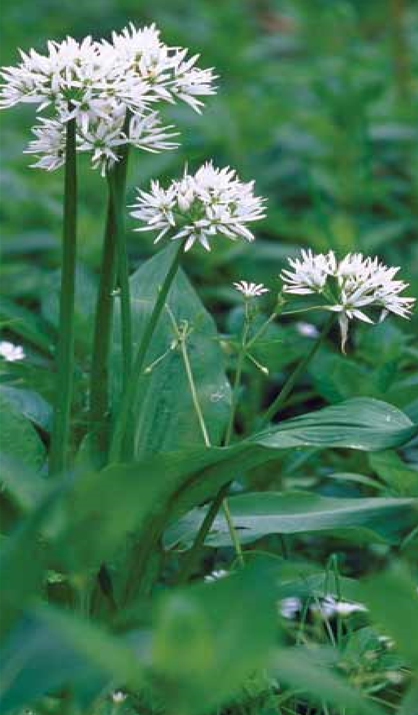
Meadowsweet
Crios Chù Chulainn
Use Appears in April and flowers in June and July. The abundant flowers are good for adding flavour to sweet foods and make a delicious cordial. The young leaves can be used as a salad vegetable (although the flavour is not to everyone’s liking).
Health and other uses
The Gaelic name is connected to the great Gaelic warrior, Cù Chulainn.
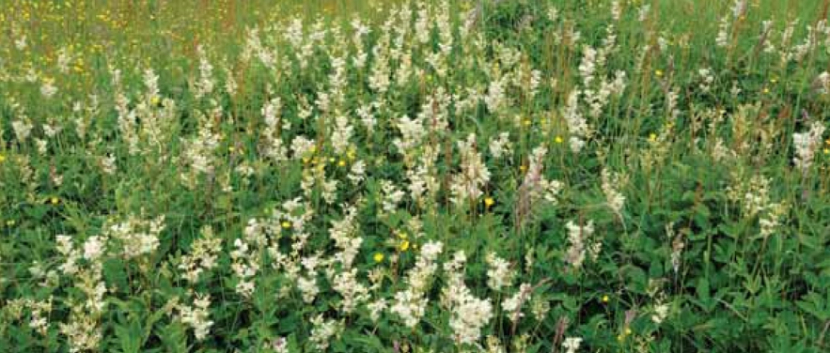
Greater Plantain
Cuach Phàdraig
Use The youngest leaves can be used in salads but the leaves are better boiled with the veins removed - it has a mushroomy taste and an appearance similar to spinach.
Health and other uses
Traditionally used by the Gaels as a healing poultice.
Common Nettle
Deanntag
Use Young leaves make an excellent soup and can be used whenever you would use young spinach. Harvest the youngest leaves from the top of the plant in spring and autumn. Regular trimming encourages a fresh supply of new growth. Boil or steam - which removes the stinging hairs.
Health and other uses
Nettles are a good source of protein, Calcium and other minerals, vitamin C and betacarotene. Avoid during summer.
Bramble
Dris
Use Brambles are among the best foraged food that can be gathered and make delicious puddings and jams. Tea can also be made from the leaves.
Health and other uses
Beware of the thorns! Known in Gaelic folklore as ‘an dris bheannaichte’ - ‘the blessed briar’.
Elder
Droman
Use The cream coloured flowers of the elder tree can be gathered between May and July. A sweet tasting cordial or champagne can be made. The flowers are really good also as a light, starter snack when fried in tempura batter. The deep red berries that follow are good for making wine, jam and chutney and vinegar.
Health and other uses
Don’t gather too many flowers as there will be no berries in the autumn!
Beech
Faidhbhile
Use The young leaves can be eaten (before they have properly opened, when they are bright green) and are good with asparagus or in a salad. An alcoholic drink can be made from them too. Oil can be extracted from the masts or fruits.
Health and other uses
Beech was not native to the Highlands and therefore few traditional uses are to be found in Gaelic culture.
Wood Sorrel
Feada Coille
Use The leaves have a sharp taste and are good in salads, dressings and sweets. It’s lemony taste goes very well with fish. The flowers are also tasty in salads.
Health and other uses
Good source of vitamin C and beta-carotene. Don’t tear off the whole plant. Don’t eat too much as it contains oxalic acid
Chickweed
Fliodh
Use The young leaves are good in salads and used in a similar way to spinach.
Health and other uses
Rich in Magnesium, Phosphorous, Copper, vitamins C, B6, B12, D & A.
Heather
Fraoch
Use Tea is made from the flowers (mixed with flowers of other plants). Beer or ale is also made from the flowers.
Health and other uses
Heather was also used for thatching and in mattresses. Cross-leaved Heath is useful for scouring pots.
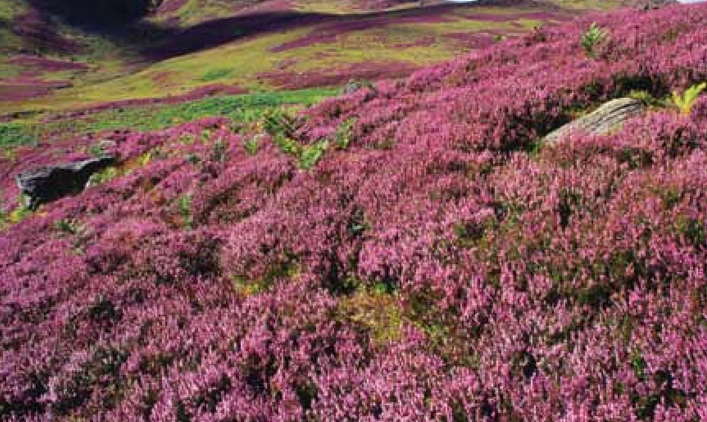
Douglas Fir
Giuthas MhicDhùghlais
Use The young needles are soft and edible and can be used to make a tea (rich in vitamin C) or as a flavouring in baking.
Health and other uses
This tree is not native to Scotland - it therefore is little mentioned in Gaelic culture.
Elm
Leamhan
Use The young seeds can be eaten before they dry out. They are slightly sweet and good in salads.
Health and other uses
Elm seeds are particularly nutritious, containing up to 45% crude protein.
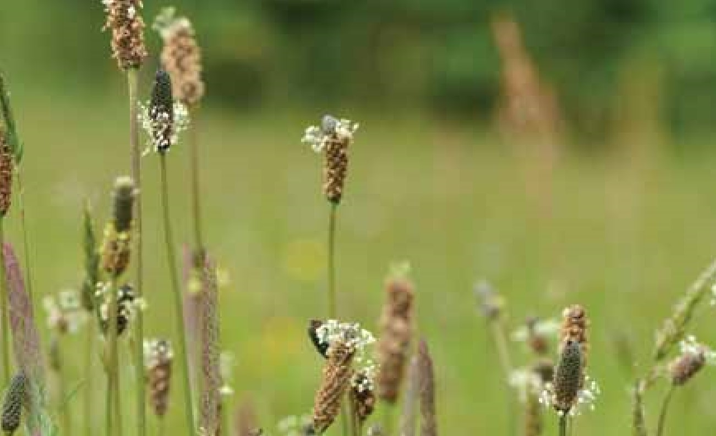
Larch
Learag
Use An alcoholic drink (similar to vodka) can be made from the fresh young tips in spring?
Health and other uses
This tree is not native to Scotland - it therefore is little mentioned in Gaelic culture.
Lady’s Bedstraw
Lus an Leasaich
Use The roots are useful for dyeing (red) and a tea is made from the flowers. The plant is also used to curdle milk;
Health and other uses
Called ‘Rù’ in Uist and not to be found in Lewis and the extreme north of the mainland.
Yarrow
Lus Chasgadh na Fala
Use The leaves are used in salads and for making a tea. Good in sauces, particularly with fish.
Health and other uses
Yarrow was used in the Highlands to clot blood.
Wild Angelica
Lus nam Buadh
Use The stalks are tasty when sugared and good in cakes; they may be used instead of celery in sauces. The leaves add flavour to salad and cheese sauce.
Health and other uses
Unmistakeable when the flowers appear in July.
Blaeberry
Lus nan Dearc
Use Exceptionally good flavour from the berries. They may be eaten raw and used to flavour drinks.
Health and other uses
High in anti-oxidants.
Opposite-leaved Golden Saxifrage
Lus nan Laogh
Use Has a pleasant enough taste although slightly bitter. The leaves are good in salads in spring and can also be cooked.
Health and other uses
Sometimes to be found in marshy areas and at springs - make sure you don’t trample the surrounding environment when collecting.
Wood Avens
Machall Coille
Use The leaves are good in soups and stews. Use the roots (raw or dried) as an alternative to cloves.
Health and other uses
Found at forest edges and roadsides. Not present in the Western Isles.
Mint
Meannt
Use Many uses. The leaves are good in condiments, salads and sweets, and also to make tea.
Health and other uses
If it is gathered near sheep pasture, boil the leaves well.
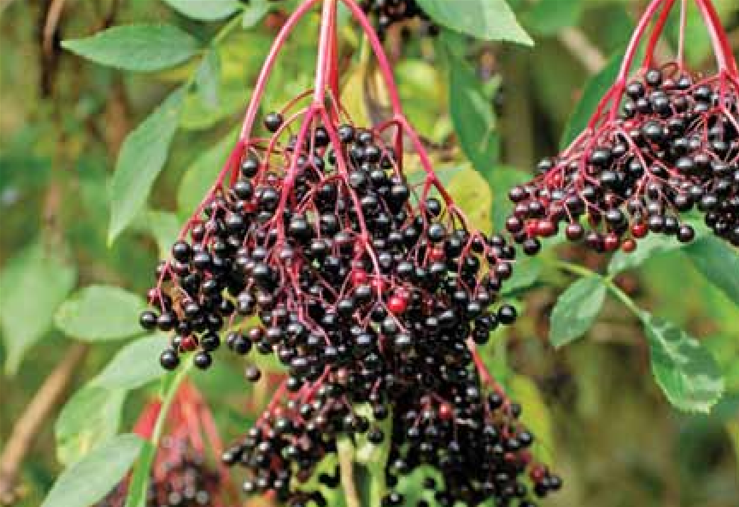
Sweet Cicely
Mirr
Use Has a distinctive aroma and taste similar to aniseed. Use the leaves in salads and with fish; also to add flavour to drinks such as vodka. Sweet cicely sometimes grows beside hemlock which looks very similar and is deadly poisonous. Once again, familiarity with the carrot family in general (umbellifers) is essential.
Health and other uses
High in vitamin C. The hips can still be gathered in winter.
Hogweed
Odharan
Use Identify your hogweed area and visit it year after year.
Fry the very young shoots in butter. Use the dried seeds as a spice instead of cardamom.
Health and other uses
Be careful to avoid Giant Hogweed.
Dog Rose
Preas nam Mucag
Use Syrup is made from the rose hips. The petals are good in salads and sweets.
Health and other uses
High in vitamin C. The hips can still be gathered in winter.
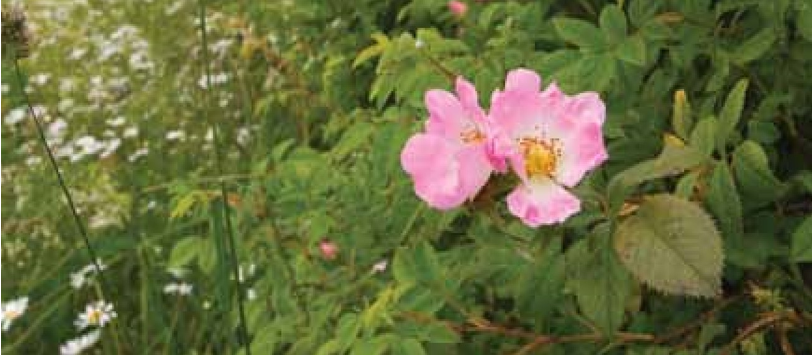
Bog Myrtle
Roid
Use The leaves are used to flavour beer and other drinks. Good for roasting with chicken.
Health and other uses
Will keep midges at bay!
Common Sorrel
Samh
Use The leaves have a bitter taste; can be used in recipes as a substitute for vinegar or lemon. Good with fish and in French cuisine, also in salads and cooked. Sheep’s Sorrel is used in almost the same way. There is a saying in South Uist - ‘cho searbh ri sùgh nam buinteagan’ - ‘as bitter as the juice of Sheep’s Sorrel’.
Health and other uses
High in vitamin C. Also high in oxalic acid, so don’t eat too much of it.
White Clover
Seamrag Bhàn
Use Use the flowers in bread, soup and stew. They will add a pea-like taste to salads. Leaves can be used in salads and condiments too.
Health and other uses
Leaves are high in protein, Calcium, Magnesium and thiamine.
Red Clover
Seamrag Dhearg
Use (See White Clover).
Health and other uses
Leaves are high in protein, Calcium, Magnesium and thiamine.
Hairy Bittercress
Searbh-bhiolar Ghiobach
Use The leaves have a strong, bitter, peppery taste and can be used in salads and to make pesto.
Health and other uses
High in vitamins A & C and Calcium, Phosphorous and Magnesium.
Hawthorn
Sgitheach
Use Young buds and fresh leaves can be eaten in spring – when they ‘harden and go shiny, they are less palatable. The flowers are good in salads (when picked young) and with rabbit.
The haw berries are good for making jelly that goes deliciously with meat.
Health and other uses
The haws, flowers and leaves are good for the heart and the haws are a good source of vitamin C.
Ribwort Plantain
Slàn-lus
Use Can be used in the same way as Greater Plantain.
Health and other uses
Good source of vitamin C.
Primrose
Sòbhrag
Use The leaves are good in salads or condiments and are sweet tasting. The flowers can be used in salads, with roasted meat or can be sweetened with sugar and wine can also be made from the flowers.
Health and other uses
Pick from an area that is ‘speckled’ with primroses and take care not to tear out the roots.
Lime
Teile
Use The buds and fresh leaves are tasty when eaten raw and tea can be made from the flowers.
Health and other uses
Some say that the tea is good for the heart and for digestion.
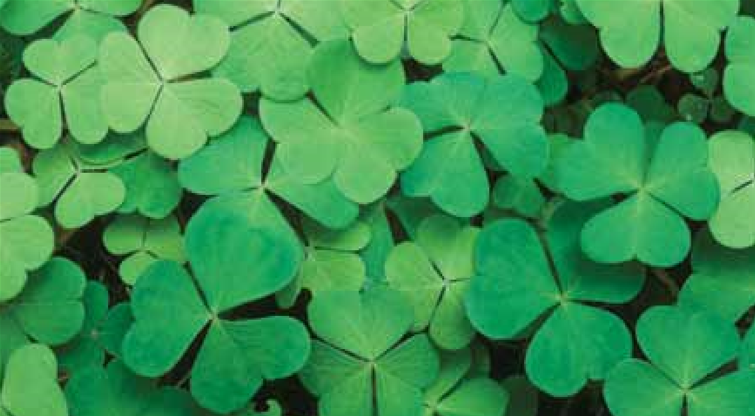
By The Shore
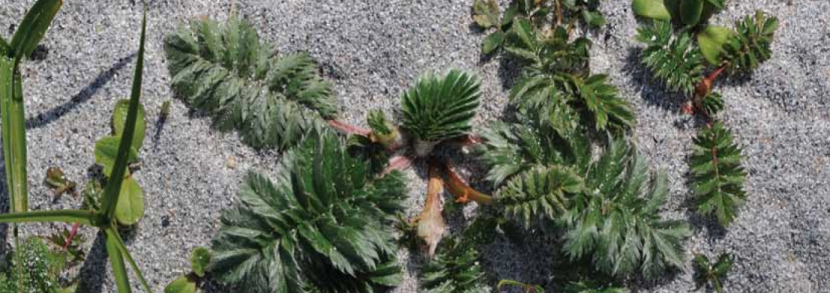
Sea Beet
Biatas Mara
Use Better in spring, but good to eat throughout the year, beet is found above the shore. The leaves are tasty, either raw or cooked; they are good steamed. Tasty in soups, or with fish or lamb.
Health and other uses
Rich in vitamins and minerals. Cut off the leaves but don’t remove the whole plant.
Silverweed
Brisgean
Use The roots can be roasted (or boiled or fried) - similar to parsnip. The roots can be ground and made into flour (for making bread). Please note that to uproot any plant, you must have the landowner’s permission.
Health and other uses
‘Brisgean beannaichte an earraich - Seachdamh aran a’ Ghàidheil’ - ‘Blessed silverweed of spring - seventh bread of the Gael’ - an important source of food in times of hunger. As ever, do not pick any plant except in places where it is commonly found.
Sea Kale
Càl na mara
Use Found above the shoreline. The stalks and leaves are tasty in spring (purple to begin with, turning green). Cook the stalks as you would asparagus; the leaves as cabbage, before they get too big). The stalks can be eaten raw in salads. The flowers appear in May and look similar to broccoli. Seed pods are similar to peas and taste like cabbage.
Health and other uses
Contains plenty of fibre. High in iodine, sulphur, vitamin C and minerals. Used by many Europe cultures, but not as common in Scotland, especially in the north - ensure that it is foraged sustainably.
Sea Sandwort
Lus a’ Ghoill
Use Found above the shoreline in sand or shingle. The stalks and young leaves are tasty (slightly bitter) and better before flowering (they are very small); use as a potherb. The leaves can be pickled to make sauerkraut.
Health and other uses
High in vitamins A and C.
Common Scurvygrass
Maraiche
Use Use the leaves as a spice – they are strong tasting like mustard or horseradish.
Health and other uses Used in the past by sailors to keep scurvy at bay. High in vitamin C. Found above the shoreline.
Sea Radish
Meacan Ragaim Uisge
Use Good steamed as a winter vegetable (when the plant is short); the stalks are good in stir fries. Eat the stalks and leaves as vegetables (or sushi) and the young seed pods as you would eat radishes. Has a strong, slightly hot taste.
Health and other uses
Found near the shore.
Common in the south-west of Scotland (Galloway). The yellow flowers are in the shape of a cross. The plant grows quite tall in summer.
Sea Buckthorn
Ràmh-dhroigheann Mara
Use The fruit (orange, ripe in autumn) is rich in vitamin C and anti-oxidants and has a sharp taste. The juice can be drunk, or the berries and leaves dried and infused as a tea.
Health and other uses Grows naturally behind beaches but can spread inland.
Sea Plantain
Slàn-lus na Mara
Use The leaves can be eaten raw or cooked and are tasty, especially with fish. The seeds are used in the same way or ground to make flour. Health and other uses Found by the shore. Good source of Calcium and Phosphorous.
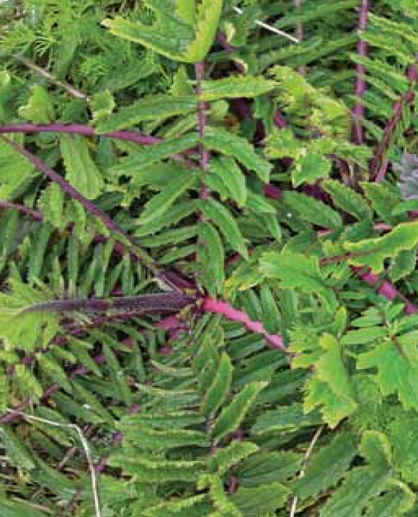
Foraging for Seaweed
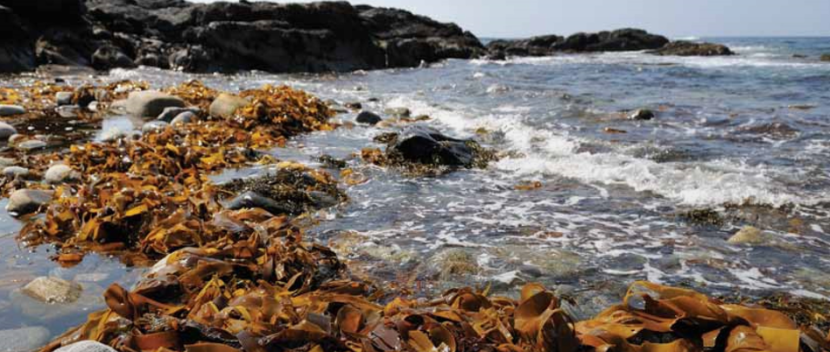
Carrageen
Cairgein
Use Low on the shore, grows on rocks.
Gathered especially in spring. Dried and stored. Eaten as salad in Japan but usually used as a thickening agent in jelly in Scotland. Good for soups and stews and as a sweet with milk and sugar.
Health and other uses Traditionally used by those suffering with a cough. A balanced food, high in magnesium.
Dulse
Duileasg
Use Found low on the shoreline, on rocks and is gathered, especially in summer. It is tasty raw - fresh or dried and has a salty, nutty taste. Wash in water and mix in salads. Fry in butter or make crisps with it. Is often eaten as dulse pudding.
Health and other uses High in protein, minerals, vitamins and trace elements. Low in sodium, high in vitamin K.
Pepper Dulse
Duileasg Piobarach
Use Good in sauces, especially with fish and in stir-fries. Used as an alternative to pepper.
Health and other uses Little research has been conducted.
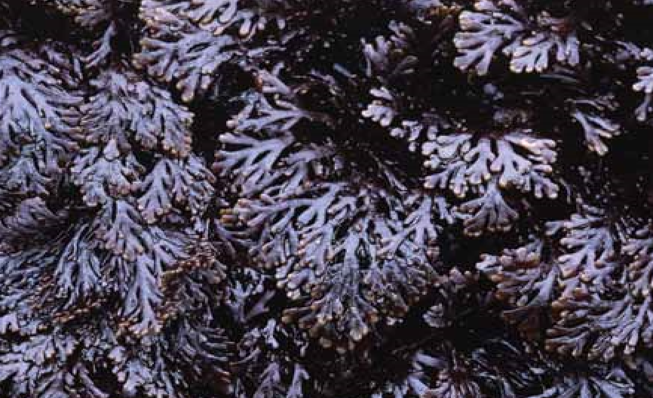
Channelled Wrack
Feamainn Chìrean
Use
High on the shore.
Fed to cattle in the Highlands but also eaten by humans; tastes good when the air-filled bladders are present.
Health and other uses
High in vitamin C and trace elements, including Selenium.
Dumont’s Tubular
Weed
Feamainn Phìobach
Use
In pools and mid-shore where there is shelter.
Tasty raw at the shore or in salads and sushi. Similar to noodles in soup and stews but fragile if boiled too vigorously.
Sprinkle with flour and fry. Tastiest in spring.
Health and other uses
Shorter and finer than dead-man’s-rope, which isn’t pleasant at all.
Sea Lettuce
Glasag
Use Often brought to shore by the tide.
Good eaten raw in salads and omelettes, with fish or meaty stews.. Can be used in bread such as focaccia. Health and other uses High in protein, iron, vitamin B12, Calcium, Magnesium, Manganese. Higher in vitamin C in summer.
Gutweed
Glasag Chaolanach Use Found throughout the shoreline. Use as you would sea lettuce. Good fried, especially when brown and hard.
Health and other uses
High in Calcium and trace elements and vitamins. But be careful - it is often to be found in abundance close to sewage outflow.
Sea-thong
Iallan Mara
Use Found low on the shore.
Adds a lamb-like taste to soups and stews and a nutty taste to salad and pasta. Mix with spaghetti to add some extra flavour. Health and other uses. High in Calcium, Magnesium, trace elements and vitamins.
Sweet or Sugar Kelp
Langadal, Ròc
Use Found below the sandeel shore. Comes to shore in heaps. Sweet, especially when not too young. Eaten raw or roasted. Can be dried or frozen to preserve it. Good with many types of food, from stews to biscuits and cakes. Makes good crisps and ‘mìlsean-mara’ or ‘sea-sweets’.
Health and other uses
Contains a variety of minerals, vitamins and trace elements. BUT high in iodine - so don’t eat too much of it.
Badderlocks
Mircean
Use Found at low tide at the time of spring-tide. Similar to Japanese wakame but must be cooked for 40 minutes, compared with15 mins for wakame. Good for making soup (eg miso soup). Has a chicken-like taste cooked with rice. Good in salads if steeped beforehand in lemon juice. If steeped in water, the water can then be used as a cooking liquid.
Health and other uses
High in Calcium, vitamin B & trace elements. Highest in vitamin C at the end of spring. High in vitamin K in early summer. High in vitamin B12 in winter and early spring.
Sloke, Laver
Slòcan
Use Finely textured seaweed that grows thickly on rocks; colour between brown and purple.
Similar to Japanese nori. Mild taste, slightly nutty. Good for making sushi. Good toasted and crumbled in salads. Tasty in stews, soups and pesto. Can be used in recipes as an alternative to spinach. Good also with sweets, especially with chocolate and ginger.
Health and other uses
High in vitamins A, B, C, E, K, thiamine and beta-carotene. Has more protein than other seaweeds. A great amount can be eaten without going over the WHO recommended
level of iodine. High levels of phosphorous, potassium, iron, copper, manganese and zinc.
Oarweed, Sea Tangle, Forest Kelp
Stamh
Use It grows thickly at the bottom of the shore.
Good with beans and with meat, cheese, vegetables and fish. Nutty taste. Used for dashi in Japan. Makes tasty crisps.
Health and other uses
High in minerals, vitamins and trace elements. Care must be taken though as it contains high levels of iodine.
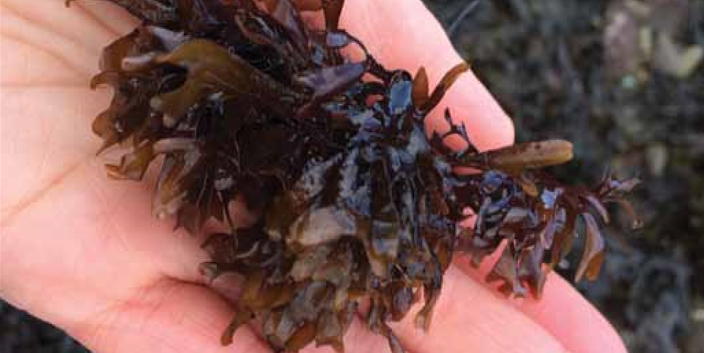
Document downloads
Disclaimer: Scottish Natural Heritage (SNH) has changed its name to NatureScot as of the 24th August 2020.
At the time of publishing, this document may still refer to Scottish Natural Heritage (SNH) and include the original branding. It may also contain broken links to the old domain.
If you have any issues accessing this document please contact us via our feedback form.
